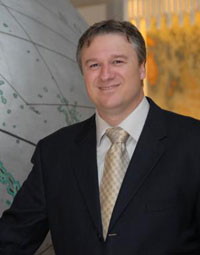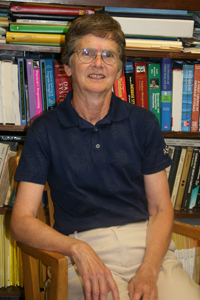Bright Scholar
 When asked about his work and academic experience, mathematics professor Steven Broad responds with a smile, “It’s complicated.” While Broad says he can’t remember a time when he wasn’t interested in mathematics, he began his education as a physics major.
When asked about his work and academic experience, mathematics professor Steven Broad responds with a smile, “It’s complicated.” While Broad says he can’t remember a time when he wasn’t interested in mathematics, he began his education as a physics major.
At that time he was an intern at NASA Lewis Research Center (now John Glenn Research Center) in Cleveland, Ohio. “I learned firsthand from working on several projects that I enjoyed the interplay between mathematics, physics, and engineering,” he says. Soon after, his real analysis professor said to the class, “When I was a student and I learned the Bolzano-Weirstrass theorem for the first time, I knew then that I wanted to be a mathematician and teach this idea to students.”
Broad thought, “Me too.” And he made the switch to mathematics, which led him down a varied and exciting career path. Broad earned his master’s degree from Washington University in St. Louis prior to his work experience and received his PhD from the University of Notre Dame more recently.
Broad has worked as a software engineer, consultant, and applied mathematician for several companies mostly doing work related to scientific or mathematical programming.
He has worked on projects related to: microgravity fluid dynamics, radiation oncology, power systems optimization, portfolio optimization, asset and option evaluation, stochastic risk analysis, and economic evaluation of electrical transmission networks.
“The common thread in these projects is the use of mathematics and computer science to solve complex problems in the business world,” says Broad.
Impressed yet?
Recently, the J. William Fulbright Foreign Scholarship Board selected Broad as a Fulbright scholar grantee to Brazil. During the summer of 2011 Broad conducted research in his specialty, classical dynamical systems and differential geometry, and taught a seminar on the subject at the Instituto de Matemática e Estatística of the Universidade de São Paulo (USP-IME).
Broad brings a wealth of experience and expertise to Saint Mary’s students. He teaches courses in mathematics and computer science, including introduction to statistics, data structures, and system analysis and design.
Perhaps best of all, Broad is accessible to his students when they need assistance, and he makes subjects like advanced calculus accessible to them too. He especially enjoys watching students’ learning progress throughout a semester. He says they often can’t see their growth because they don’t have much perspective on the increasing difficulty of the material. Broad makes a point to illustrate it for them.
“It reminds me of a backpacker who, after hiking uphill for several hours, turns around and sees the smallness of things in the valley below and says ‘Wow! I can't believe how high I've climbed. The view from here is beautiful!’ The backpacker then turns back around and finishes the climb, because she wants to see the view from the summit,” says Broad.
The key to Broad’s teaching style is changing students’ perspective on their own abilities. One of the greatest obstacles to their learning can be the memory of past negative experiences.
“Giving students opportunities to succeed often comes down to helping deconstruct their learned disinclination to the subject matter —“I’ve always been bad at math”—being available to students, and grounding our class time in concrete examples that are close to our lives,” says Broad.
Broad encourages his students to treat learning math and computer science as if they are learning new languages in which to express their ideas. “This can help students to keep from getting lost in the symbols and formulas and start to think about mathematics and computing as a set of ideas that they already use in their lives, and with a little practice can improve their use of them.”
Dream On
 “I love the way we work as a community at Saint Mary’s. I could give a lecture to 200 students. But to me, that’s not what learning is about. Learning is a conversation.” -- Associate Professor Mary Connolly
“I love the way we work as a community at Saint Mary’s. I could give a lecture to 200 students. But to me, that’s not what learning is about. Learning is a conversation.” -- Associate Professor Mary Connolly
On the south wall of Associate Professor Mary Connolly’s office, there is a poster featuring a runner mid-stride and the words “Pursue your dream. Reach for the best.” It’s an apt intention for the mathematics professor and long-distance runner. She has been pursuing her dreams all her life -- whether in mathematics , computer science, or on the blacktop in her sneakers each morning -- and she encourages her students to do the same.
Her determination to pursue a career in mathematics, Connolly explains, grew from a long history of intelligent women in her family. “There are four generations of women in mathematics in my family,” she says. “It was natural. I never got the message that there was anything funny about women in mathematics.”
The dedicated mathematician joined the Saint Mary’s faculty 28 years ago when she transferred from an adjunct position at Indiana University South Bend. Connolly originally taught calculus, finite math, and statistics, then returned to graduate school to complete a degree in computer science. She added computer science classes to her repertoire, and took on advisement of students in the Management Information Systems (MIS ) major. It is a task she shares with the business administration department, since MIS is a major that combines classes from both areas.
As a first-year student advisor, Connolly has made the math class recommendations for over 25 years. She understands the kinds of doubts that students come in with regarding their math placements. “I tell them, ‘You will work really hard. But you can do it,’” she says.
Connolly’s teaching philosophy suits her high-energy personality. “I can’t stand a quiet class,” she says. The former marathon runner loves the summer and winter Olympics, and she likes to incorporate examples from the events into her classes to teach her students all manner of calculations. “Last year in one of our computer science classes we created a program to track luge times,” she enthuses. “I love the luge. I think it’s insane,” she adds.
Connolly knows she is making a real connection with her students when she shares these different sides of herself in class. “I want my students to know this is a whole person here, not just someone who walked out of a textbook.” A prayerful person, Connolly starts each class with a prayer or reflection, from traditional Catholic prayers, to Sister Madeleva’s poems, to Native American prayers. She hopes this quiet encouragement gives confidence to Saint Mary’s women as they pursue their own dreams. Connolly is serious about helping her students succeed. But her playful side, which includes an uplifting sense of humor and a penchant for Oreo cookies, tells them that this mathematician-turned-marathoner is in it for the long haul.
